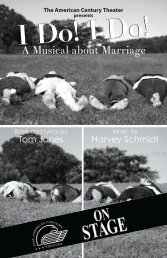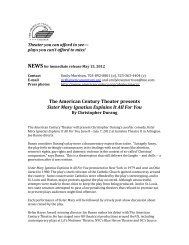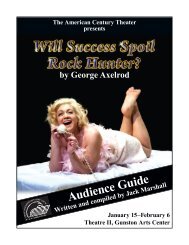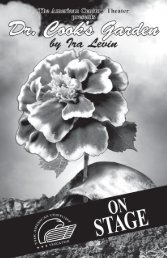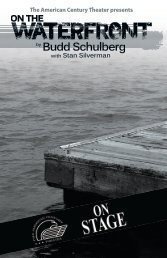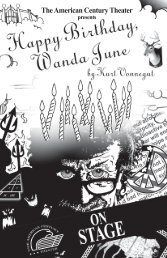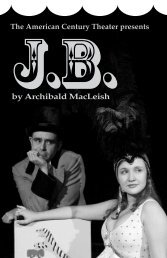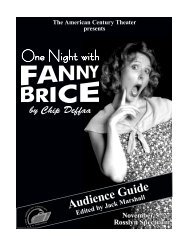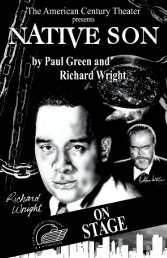Stage Door - The American Century Theater
Stage Door - The American Century Theater
Stage Door - The American Century Theater
Create successful ePaper yourself
Turn your PDF publications into a flip-book with our unique Google optimized e-Paper software.
Audience Guide<br />
Written and compiled by Jack Marshall<br />
April 8–May 7, 2011<br />
<strong>The</strong>atre Two, Gunston Arts Center
<strong>The</strong>ater you can afford to see—<br />
plays you can’t afford to miss!<br />
About <strong>The</strong> <strong>American</strong> <strong>Century</strong> <strong>The</strong>ater<br />
<strong>The</strong> <strong>American</strong> <strong>Century</strong> <strong>The</strong>ater was founded in 1994. We are a professional company<br />
dedicated to presenting great, important, but overlooked <strong>American</strong> plays of the twentieth<br />
century . . . what Henry Luce called “the <strong>American</strong> <strong>Century</strong>.”<br />
<strong>The</strong> company’s mission is one of rediscovery, enlightenment, and perspective, not<br />
nostalgia or preservation. <strong>American</strong>s must not lose the extraordinary vision and wisdom<br />
of past playwrights, nor can we afford to surrender our moorings to our shared cultural<br />
heritage.<br />
Our mission is also driven by a conviction that communities need theater, and theater<br />
needs audiences. To those ends, this company is committed to producing plays that<br />
challenge and move all <strong>American</strong>s, of all ages, origins and points of view. In particular,<br />
we strive to create theatrical experiences that entire families can watch, enjoy, and<br />
discuss long afterward.<br />
<strong>The</strong>se audience guides are part of our effort to enhance the appreciation of these works,<br />
so rich in history, content, and grist for debate.<br />
<strong>The</strong> <strong>American</strong> <strong>Century</strong> <strong>The</strong>ater is a 501(c)(3) professional nonprofit theater company<br />
dedicated to producing significant 20th <strong>Century</strong> <strong>American</strong> plays and musicals at risk of<br />
being forgotten.<br />
<strong>The</strong> <strong>American</strong> <strong>Century</strong> <strong>The</strong>ater is supported in part by Arlington County through the<br />
Cultural Affairs Division of the Department of Parks, Recreation, and Cultural<br />
Resources and the Arlington Commission for the Arts.<br />
This arts event is made possible in part by the Virginia Commission on the Arts and the<br />
National Endowment for the Arts, as well as by many generous donors.
Contents<br />
Working Women in the Great Depression:<br />
<strong>The</strong> Tragedy Outside the <strong>Stage</strong> <strong>Door</strong> . . . . . . . . . . . . . . . . . . . . . . . . . . . . . 1<br />
<strong>The</strong> Writing on the Wall:<br />
<strong>Stage</strong> <strong>Door</strong> and the Triumph of Hollywood Over Broadway . . . . . . . . . . . . 3<br />
Hollywood’s <strong>Stage</strong> <strong>Door</strong>: A Quiz . . . . . . . . . . . . . . . . . . . . . . . . . . . . . . . 6<br />
<strong>The</strong> Playwrights<br />
George S. Kaufman . . . . . . . . . . . . . . . . . . . . . . . . . . . . . . . . . . . . . . . . . 7<br />
Edna Ferber . . . . . . . . . . . . . . . . . . . . . . . . . . . . . . . . . . . . . . . . . . . . . . 10<br />
<strong>Stage</strong> <strong>Door</strong> Hinges:<br />
Icons, Candies, Shakespeare, and That Damn Piano . . . . . . . . . . . . . . . . . 12
Working Women in the Great Depression:<br />
<strong>The</strong> Tragedy Outside the <strong>Stage</strong> <strong>Door</strong><br />
In <strong>Stage</strong> <strong>Door</strong>, Edna Ferber and George S. Kaufman show the world of a<br />
boarding house for actresses in New York City during the 1930s. It is an<br />
oasis of sorts for the young women, as they struggle to survive in a<br />
challenging profession during tragic times. <strong>The</strong> way the aspiring actresses<br />
behave in that boarding house is best understood by recalling what life was<br />
life outside of it.<br />
During the Great Depression, women made up 25 percent of the workforce.<br />
Yet their jobs were more unstable, temporary, or seasonal than those of men,<br />
and their unemployment rate was much higher. <strong>The</strong> prevailing cultural view<br />
that “women didn’t work” was a severe handicap; neither men in the<br />
workforce nor the unions nor any branch of government accepted the reality<br />
of working women, and this bias caused women intense hardship.<br />
<strong>The</strong> 1930s were especially hard on single, divorced, or widowed women—<br />
and harder still on those who were black. In the northern states, 23.2 percent<br />
of white women and 42.9 percent of African-<strong>American</strong> women were counted<br />
as jobless in the 1937 census.<br />
At the start of the Depression, one study found that homeless women were<br />
most likely to be factory and service workers, domestics, garment workers,<br />
waitresses, and beauticians. Many of these women, later known as<br />
“survivalist entrepreneurs,” became self employed in response to a desperate<br />
need to find an independent means of living. In New York City, they could<br />
also try to enter the entertainment industry, at all its levels, from low-rate<br />
“sex shows” to the Broadway stage. Today, actresses looking for work may<br />
be desperate; in the Thirties, desperation drove women to act.<br />
By 1931, unemployment had spread to the middle class. White-collar and<br />
college-educated women, accustomed to regular employment and stable<br />
homes, became the nouveau poor. <strong>The</strong> demand for “female beds” in<br />
homeless shelters was three times what it had been just a few years earlier.<br />
Those beds, however, were intended for the most hopeless and destitute<br />
women, and the stigma of resorting to them caused them to be avoided by<br />
1
women who were thrust into homelessness for the first time. Some ended up<br />
in shelters, but the rest sought other solutions, though government agencies<br />
provided few alternatives. As an unemployed female college graduate told a<br />
social worker in 1932, “Having an address is a luxury just now.”<br />
<strong>The</strong>se newly destitute women drifted from one unemployment office to the<br />
next, resting in Grand Central or Pennsylvania Station, riding the subway all<br />
night (known as staying in the “five-cent room”), or sleeping in the park.<br />
<strong>The</strong>y ate in penny kitchens. Fearful and ashamed to ask for charity, these<br />
women could be on the verge of starvation before they sought help. <strong>The</strong>y<br />
were, according to one report, often the “saddest and most difficult to help.”<br />
<strong>The</strong>se women “starved slowly in furnished rooms. <strong>The</strong>y sold their furniture,<br />
their clothes, and then their bodies.”<br />
Gender stereotypes of the day often dictated that women return to the rural<br />
homestead during times of trouble, to help out around the home and be given<br />
shelter, supposedly in family homes large enough to accommodate everyone.<br />
But the reality, especially in cities like New York, was not so idyllic. <strong>The</strong><br />
family often lived in a strained, overburdened, overcrowded household in a<br />
small apartment that often contained severe domestic troubles of its own.<br />
Returning home was often not an option at all. Few had rural roots to fall<br />
back upon, and those who did often looked on that course as a humiliating<br />
admission of failure and inadequacy. <strong>The</strong> new, emancipated woman of the<br />
Roaring Twenties was now left without a respectable face as the Depression<br />
deepened.<br />
Over half of these job-hunting women had never married, while others were<br />
divorced, deserted, separated, or widowed. Some had dependent parents and<br />
siblings who relied on them for support. Some had children who were living<br />
with extended family. In New York, 85 percent of the women seeking work<br />
had been self-supporting only a few years earlier. Some had been<br />
unemployed for months and others, for a year or more. Once savings and<br />
insurance were used up, they tried their informal social networks. <strong>The</strong>se<br />
were quickly tapped out, if not already exhausted.<br />
For the most part, the tangible evidence of breadlines, Hoovervilles, and<br />
men selling apples on street corners did not contain images of urban women.<br />
Unemployment, hunger and homelessness were considered a man’s<br />
problem. In photographic images and news reports, destitute urban women<br />
seldom appear. Most of the New Deal work programs set up to help the<br />
unemployed focused on male workers.<br />
2
In this toxic environment of little hope and less opportunity, the young<br />
actresses of <strong>Stage</strong> <strong>Door</strong> tried to find rescue in show business. Ferber and<br />
Kaufman accurately depict their determination and courage, but what we see<br />
is even more admirable in light of the conditions facing them.<br />
<strong>The</strong> Writing on the Wall:<br />
<strong>Stage</strong> <strong>Door</strong> and the Triumph of Hollywood<br />
Over Broadway<br />
— Jack Marshall<br />
George S. Kaufman was a wise man, and he knew where it all would end.<br />
He used <strong>Stage</strong> <strong>Door</strong> to warn everyone, and nobody was listening. Oh, they<br />
laughed. But they didn’t believe.<br />
Although <strong>American</strong> theater was in the midst of its greatest dominance by the<br />
1930s, the handwriting was on the wall for those with the acuity to read it.<br />
<strong>The</strong> stage was the past, the screen was the future, and the present was<br />
ominous. Hollywood, easy to deride as the invention of gypsies, clowns,<br />
oddballs, and foreign entrepreneurs with funny accents, knew how to excite<br />
the public, and was gradually making the theater seem stodgy, elitist, and<br />
old-fashioned. Like a vampire, the film industry, energized by the addition<br />
of sound, was draining Broadway of its lifeblood: talent.<br />
<strong>The</strong>ater artists had to make a choice: stay in New York, with its harsh<br />
winters and gray, shuffling breadlines, working for a business staggering<br />
from layoffs and cutbacks, or move to Hollywood, where it was sunny all<br />
year round and money was thrown at you in fistfuls by studio executives.<br />
<strong>The</strong> choice for many was obvious. Almost every Broadway actor was<br />
looking for a shot at movies. <strong>The</strong> old silent film stars were often useless for<br />
talking pictures, and performers with good voices and stage experience were<br />
needed to take their place.<br />
Broadway’s most acclaimed leading man, John Barrymore, had led the way<br />
even before talkies, with his famous siblings, Lionel and Ethel, close behind.<br />
3
Broadway comics like W.C. Fields, Will Rogers, Bob Hope, and the Marx<br />
Brothers abandoned Broadway for Hollywood in droves. Van Heflin, Jean<br />
Arthur, Jane Wyatt, Barry Fitzgerald, Harold Gould, Henry Fonda, Fay<br />
Bainter, Walter Huston, Ned Glass, Katharine Hepburn, Basil Rathbone,<br />
Brian Aherne, Margaret Hamilton, Irene Rich, Josephine Hull, Tom Ewell<br />
and Mary Wickes (both in the original production of <strong>Stage</strong> <strong>Door</strong>), James<br />
Stewart, James Cagney . . . leading men and ladies, supporting actors and<br />
actresses, character players . . . the list of Broadway actors who left New<br />
York for Hollywood in the Thirties is long, distinguished, and depressing.<br />
Sure, there were plenty of actors to take the places of those who departed,<br />
but the gradual effect began to be apparent: the most beautiful actresses, the<br />
most dynamic actors, and the most skilled supporting players were<br />
increasingly to be seen on screen, for a fraction of the price of a Broadway<br />
ticket. Could you blame them? Even if you got cast, a play might fold after<br />
only a few performances. “From 1932 through 1934,” James Stewart<br />
recalled, “I’d only worked three months. Every play I got into folded.” In<br />
Hollywood, you had a contract, you had guaranteed income. You could eat.<br />
If, like Stewart, you were talented enough to receive an offer from a studio,<br />
you would be a fool not to leave New York. So the best actors left.<br />
<strong>The</strong>n the singers and dancers left, too. Hollywood’s early musicals had been<br />
embarrassing, but in 1933, a former marine drill instructor and Broadway<br />
dance director named Busby Berkeley conceived the hoofing sequences in<br />
the quintessential backstage film musical, 42nd Street, and redefined the<br />
genre. His visual skill at manipulating chorus girls and the camera finally<br />
made the Hollywood musical more than competitive with its stage<br />
counterparts (Broadway fought back in the Forties, with the invention of the<br />
classic Broadway musical) and soon all the studios were churning out<br />
Hollywood musicals written by and starring the Broadway talent it had lured<br />
away, such as Fred Astaire, Eleanor Powell, Ginger Rogers, Nelson Eddy,<br />
Jerome Kern, Irving Berlin, the Gershwins, Dorothy Fields, Cole Porter,<br />
Johnny Mercer, Desi Arnaz, Eddie Bracken, Eddie Albert, Van Johnson,<br />
Jimmy Durante, Ray Bolger, the Nicholas Brothers, Clifton Webb, Marilyn<br />
Miller, and many more.<br />
Kaufman also was seduced by Hollywood, writing the screenplay of the<br />
Marx Brothers’ A Night at the Opera in 1935. He hated the process and<br />
culture of the movies and made his disapproval known in <strong>Stage</strong> <strong>Door</strong>; he<br />
was to return to the theme with more venom in Hollywood Pinafore. <strong>The</strong><br />
play’s turncoat playwright, who compromises his artistic ideals for cash and<br />
4
Hollywood fame, was a rebuke to all the serious playwrights who yielded to<br />
the studios’ siren songs, including Kaufman himself. <strong>The</strong>re were a lot of<br />
them: Ben Hecht, Charles MacArthur, Bartlett Cormack, Charles Lederer,<br />
Sidney Howard, Preston Sturges, Robert E. Sherwood, and Clifford Odets,<br />
to name just a few. <strong>The</strong> trend continued and even accelerated in the Forties<br />
and beyond.<br />
<strong>The</strong>re were those who held out against the magnet of Hollywood, of<br />
course—some because they, like Terry, the heroine of <strong>Stage</strong> <strong>Door</strong>, were<br />
passionately devoted to the stage; others, like Helen Hayes, Tallulah<br />
Bankhead, Fanny Brice, and Katharine Cornell, because their stage presence<br />
did not translate onto the silver screen, for whatever reason. Others,<br />
especially among the writing ranks, tried Hollywood and failed, or, like<br />
Kaufman, couldn’t stomach it. <strong>The</strong> bleeding there, though, continued as<br />
well.<br />
Shortly after <strong>Stage</strong> <strong>Door</strong> opened, the man who was infusing new excitement<br />
into Broadway, the mercurial (pun intended . . . sorry) Orson Welles, actor,<br />
director, designer, under 30 years old and a bona fide genius, left New York<br />
for Hollywood, too. He was Broadway’s best hope of fighting back, but<br />
Broadway was too small for him.<br />
Flash forward to 2011, and the trends that Kaufman recoiled at in 1936 have<br />
all borne predictable, if devastating, results. <strong>The</strong> stage’s most promising<br />
playwrights now usually get in one or two Broadway hits and, like Paddy<br />
Chayefsky, Aaron Sorkin, and David Mamet, head to television or movies.<br />
More often than not, young writers skip writing plays at all. A tiny<br />
percentage of the number of dramas that were produced in 1936 makes it to<br />
Broadway in a typical season now, and a small fraction of those succeed.<br />
Broadway isn’t where the jobs are, or the money, or the fame, or the<br />
prestige, and in this age of Spiderman the Musical, not the art either. In<br />
<strong>Stage</strong> <strong>Door</strong>, much is made of the fact that movie actors can’t carry a play:<br />
today, movie or TV actors are about the only actors who can sell tickets to a<br />
play, even the movie and TV actors who aren’t very good.<br />
I don’t think George saw that one coming.<br />
But as for the rest, <strong>Stage</strong> <strong>Door</strong> proves that he was able to see the writing on<br />
the wall. <strong>The</strong>ater was still riding high in 1936, but the fall was within view.<br />
As for Hollywood, it triumphed over George S. Kaufman’s protests as it has<br />
5
always triumphed, through power, cash, and arrogance. It bought <strong>Stage</strong><br />
<strong>Door</strong> and made a movie hit out of it using none of the script.<br />
Touché!<br />
Hollywood’s <strong>Stage</strong> <strong>Door</strong>: A Quiz<br />
Despite the success of <strong>Stage</strong> <strong>Door</strong> on Broadway and the fame of its<br />
playwrights, RKO assigned screenwriters Morrie Ryskind and Anthony<br />
Veiller the job of adapting the play, as in “completely rewriting it.” <strong>The</strong><br />
movie was even more popular than the movie, though the two have almost<br />
nothing in common.<br />
Almost. Your challenge: spot the plot similarities between the Wikipedia<br />
plot synopsis of the movie (it is a good one) and the stage version. You can’t<br />
count the name of the boarding house or the character names that remain.<br />
I count . . . one.<br />
Terry Randall (Katharine Hepburn) moves into the Footlights Club, a<br />
theatrical rooming house in New York. Her polished manners and superior<br />
attitude make her no friends among the rest of the aspiring actresses living<br />
there, particularly her new roommate, flippant, cynical dancer Jean Maitland<br />
(Ginger Rogers). From Terry’s expensive clothing and her photograph of her<br />
elderly grandfather, Jean assumes she has obtained the former from her<br />
sugar daddy, just as fellow resident Linda Shaw (Gail Patrick) has from her<br />
relationship with influential theatrical producer Anthony Powell (Adolphe<br />
Menjou). In truth however, Terry comes from a very wealthy, upper class,<br />
Midwest family. Over the strong objections of her father, Henry Sims<br />
(Samuel S. Hinds), she is determined to try to fulfill her dreams on her own.<br />
In the boarding house, Terry’s only supporter is aging actress Catherine<br />
Luther (Constance Collier), who appoints herself Terry’s mentor.<br />
When Powell sees Jean dancing, he decides to dump Linda. He arranges for<br />
Jean and her partner Annie (Ann Miller) to get hired for the floor show of a<br />
nightclub he partly owns. He then starts dating Jean, who, despite her initial<br />
reluctance, starts falling for the man.<br />
6
Meanwhile, well-liked Kay Hamilton (Andrea Leeds) had a great success<br />
and rave reviews in a play the year before, but has had no work since and is<br />
running out of money. She clings desperately to the hope of landing the<br />
leading role in Powell’s new play, Enchanted April. She finally gets an<br />
appointment to see Powell, only to have him cancel at the last minute. She<br />
faints in the reception area, the result of malnutrition and disappointment.<br />
Seeing this, Terry barges into Powell’s private office and berates him for his<br />
callousness. As a result, the other boarding house residents start to warm to<br />
the newcomer.<br />
Terry’s father secretly finances Enchanted April on condition that Terry be<br />
given the starring role. Powell invites Terry to his penthouse to break the<br />
news. When Jean shows up unannounced, Terry sees the opportunity to save<br />
her friend from the philandering Powell. She pretends that Powell is trying<br />
to seduce her. It works. However, it makes things uncomfortable around the<br />
boarding house. In addition to Jean’s loathing, Terry’s landing of the plum<br />
part breaks Kay’s heart.<br />
<strong>The</strong> totally inexperienced Terry is so horribly bad during rehearsals that<br />
Powell tries desperately to get out of his contract with Sims. On opening<br />
night, after she learns that the depressed Kay has committed suicide, Terry<br />
decides she cannot go on. Catherine tells her that she must, not just for<br />
herself, but also for Kay. She does, and gives a heartfelt performance. <strong>The</strong><br />
play is a hit, much to the chagrin of Terry’s father. At her curtain call, Terry<br />
pays homage to her dead friend, and Terry and Jean are reconciled.<br />
<strong>The</strong> Playwrights<br />
—Jack Marshall<br />
George S. Kaufman (1889–1961)<br />
One of the greatest wits and writers of comedy ever born on <strong>American</strong> soil,<br />
George S. Kaufman entered crying in Pittsburgh, Pennsylvania, on<br />
7
November 16, 1889. His parents were Joseph Kaufman and Henrietta Myers,<br />
both Jewish, both from successful families.<br />
Kaufman tried law school for three months at Western University of<br />
Pennsylvania (later the University of Pittsburgh), but became bored with law<br />
and took on a series of odd jobs. While working as a wholesale ribbon<br />
salesman, Kaufman met famous journalist Franklin P. Adams, to whose New<br />
York Times column he began contributing humorous pieces. <strong>The</strong>ir<br />
relationship opened the door for Kaufman to become a regular columnist,<br />
writer, and editor for the Washington Times in 1912. He moved on to New<br />
York a few years later, becoming the drama editor for <strong>The</strong> New York Times<br />
from 1917 through 1930 and there beginning his long run as America’s<br />
greatest quip artist. When a press agent asked: “How do I get our leading<br />
lady’s name in the Times?” Kaufman replied: “Shoot her.”<br />
On March 15, 1917, he and Beatrice Bakrow married, later moving into a<br />
farmhouse in Bucks County, Pennsylvania. In 1936 they had a daughter,<br />
Anne, who today guards her father’s legacy with tenacity and skill.<br />
His first solo hit as a playwright came in 1925 with <strong>The</strong> Butter and Egg<br />
Man. Kaufman soon was writing comedies with prominent partners and<br />
musicals with the likes of Rodgers and Hart and the Gershwins. With the<br />
latter, Kaufman won his first Pulitzer Prize for the book to the satirical<br />
musical Of <strong>The</strong>e I Sing (1931), co-written with Morrie Ryskind and Ira<br />
Gershwin. He received a second Pulitzer Prize in 1936 for the comedy, now<br />
considered a classic, You Can’t Take It with You, written with Moss Hart.<br />
From 1921 through 1958, Broadway featured at least one musical or play<br />
written or directed by Kaufman. With Marc Connelly, he wrote Merton of<br />
the Movies, Dulcy, and Beggar on Horseback; with Ring Lardner, he wrote<br />
June Moon; with Edna Ferber, he wrote <strong>The</strong> Royal Family, Dinner at Eight,<br />
and <strong>Stage</strong> <strong>Door</strong>; with John P. Marquand, he wrote a stage adaptation of<br />
Marquand’s novel <strong>The</strong> Late George Apley; and with Howard Teichmann, he<br />
wrote <strong>The</strong> Solid Gold Cadillac. With Moss Hart, he wrote a string of classic<br />
and near-classic comedies: Once in a Lifetime (in which he also performed),<br />
Merrily We Roll Along, and <strong>The</strong> Man Who Came to Dinner, as well as You<br />
Can’t Take It with You.<br />
Despite his claim that he knew nothing about music, Kaufman collaborated<br />
on many musical projects. His most successful include two Broadway shows<br />
crafted for the Marx Brothers, <strong>The</strong> Cocoanuts, written with Irving Berlin,<br />
8
and Animal Crackers, written with Morrie Ryskind, Bert Kalmar, and Harry<br />
Ruby. Other Kaufman musicals were Let ’Em Eat Cake, the bitter sequel to<br />
Of <strong>The</strong>e I Sing; Strike Up the Band, which fared better in the hands of<br />
Mickey and Judy than it did on the Great White Way; and I’d Rather Be<br />
Right, a musical starring George M. Cohan as a tap-dancing Franklin Delano<br />
Roosevelt (imagine that!), with songs by Richard Rodgers and Lorenz Hart.<br />
In 1945, Kaufman adapted H.M.S. Pinafore into Hollywood Pinafore.<br />
Kaufman also became a successful director of his own work and that of<br />
other playwrights, directing the original or revival stage productions of<br />
<strong>The</strong> Front Page by Charles MacArthur and Ben Hecht (1928), Of <strong>The</strong>e I<br />
Sing (1931 and 1952), Of Mice and Men by John Steinbeck (1937), My<br />
Sister Eileen by Joseph Fields and Jerome Chodorov (1940), Hollywood<br />
Pinafore (1945), <strong>The</strong> Next Half Hour (1945), Park Avenue (1946, also wrote<br />
the book), Town House (1948), Bravo! (1948), Metropole (1949), the Frank<br />
Loesser musical Guys and Dolls (for which he won the 1951 Best Director<br />
Tony Award), <strong>The</strong> Enchanted (1950), <strong>The</strong> Small Hours (1951), Fancy<br />
Meeting You Again (1952), <strong>The</strong> Solid Gold Cadillac (1953), and Romanoff<br />
and Juliet by Peter Ustinov (1957). His only credit as a film director was<br />
<strong>The</strong> Senator Was Indiscreet (1947) starring William Powell.<br />
In the 1920s, Kaufman was a charter member of the Algonquin Round<br />
Table, the famed circle of writers and show business people that included<br />
Robert Benchley, Dorothy Parker, Groucho Marx, and other notable wits.<br />
When TV arrived on the scene three decades later, he was much in demand<br />
as a panelist on game shows, where his acid wit was an asset, if sometimes<br />
an uncomfortable one. He is credited with uttering one of the most<br />
devastating insults to a celebrity ever broadcast when crooner Eddie Fisher,<br />
appearing on the 1954 panel show This is Show Business, complained that he<br />
was having trouble getting young starlets to go out with him. Kaufman’s<br />
withering response:<br />
Mr. Fisher, on Mount Wilson there is a telescope that can magnify the<br />
most distant stars to twenty-four times the magnification of any<br />
previous telescope. This remarkable instrument was unsurpassed in<br />
the world of astronomy until the development and construction of the<br />
Mount Palomar telescope.<br />
<strong>The</strong> Mount Palomar telescope is an even more remarkable instrument<br />
of magnification. Owing to advances and improvements in optical<br />
9
technology, it is capable of magnifying the stars to four times the<br />
magnification and resolution of the Mount Wilson telescope.<br />
Mr. Fisher, if you could somehow put the Mount Wilson telescope<br />
inside the Mount Palomar telescope, you still wouldn’t be able to see<br />
my interest in your problem.<br />
For a while, Kaufman lived at 158 West 58th Street in New York City, the<br />
same building that later would be the setting for <strong>Stage</strong> <strong>Door</strong>. It is now the<br />
Park Savoy Hotel.<br />
George S. Kaufman was one of the giants of the <strong>American</strong> theater scene—<br />
in his sphere, as important and successful as Arthur Miller, Tennessee<br />
Williams, or Stephen Sondheim. <strong>The</strong> <strong>American</strong> <strong>Century</strong> <strong>The</strong>ater is always<br />
honored when his work appears on our stage.<br />
Edna Ferber (1885−1968)<br />
Edna Ferber, who collaborated with George S. Kaufman on <strong>Stage</strong> <strong>Door</strong> and<br />
other Broadway plays, is barely remembered now, and her novels have<br />
fallen out of favor. When <strong>Stage</strong> <strong>Door</strong> opened in 1936, however, she was<br />
widely regarded as the preeminent female novelist in America.<br />
She was born in Kalamazoo, Michigan, on August 15, 1885, the daughter of<br />
a Hungarian-born Jewish storekeeper, Jacob Ferber, and his wife, Julia<br />
Neumann Ferber. She displayed her writing talents early as the editor of her<br />
high school newspaper, and when she graduated from high school, her senior<br />
essay so impressed the editor of the Appleton Daily Crescent that he offered<br />
her a job as a reporter at the tender age of seventeen. She decided to drop her<br />
ambition of attending college and took the job.<br />
She soon moved on to write for the Milwaukee Journal, where she worked<br />
so hard one day she collapsed in exhaustion. She was suffering from anemia.<br />
While at home recuperating, she wrote her first short story and her first<br />
novel, Dawn O’Hara, the story of a newspaperwoman. It was 1911, and<br />
Ferber was twenty-six years old.<br />
She then gained national attention for her series of “Emma McChesney”<br />
stories—there were thirty of them published in national magazines—<br />
10
following the adventures of a traveling underskirt saleswoman. Her play<br />
based on the stories, Our Mrs. McChesney, was produced in 1915, starring<br />
Ethel Barrymore.<br />
Ferber was a prolific and popular novelist. She won the Pulitzer Prize in<br />
1924 for So Big, the story of a woman raising a child on a truck farm outside<br />
of Chicago. Her best known books were Show Boat (1926), Cimarron<br />
(1929), Giant (1952), and Ice Palace (1958). Show Boat, of course, became<br />
a classic Broadway musical that spawned three movie versions and many<br />
popular songs, notably “Old Man River.” Ferber’s books were frequently<br />
adapted to film, notably Cimarron, which won the Academy Award as Best<br />
Picture in 1931, and Giant, which was James Dean’s last film.<br />
Except for the comedy based on her Mrs. McChesney stories, all of Ferber’s<br />
playwriting was confined to collaborations with Kaufman, of which Dinner<br />
at Eight, <strong>Stage</strong> <strong>Door</strong>, and <strong>The</strong> Royal Family are genuine gems, among the<br />
best of <strong>American</strong> stage comedies. <strong>The</strong> other, less successful and seldom seen<br />
fruits of their partnership were Minick (1924), <strong>The</strong> Land Is Bright (1941),<br />
and Bravo! (1948). Why only with Kaufman? <strong>The</strong> two were friends; they<br />
both were members in good standing of the literary luncheon club known as<br />
the Algonquin Round Table, and it seems clear that they liked and trusted<br />
each other. Given Kaufman’s well-earned reputation as an irrepressible<br />
ladies’ man, could there have been a romantic attachment as well?<br />
Highly dubious. <strong>The</strong>re is no evidence that Ferber engaged in a romance or<br />
sexual relationship with anyone of either gender at any time in her life. In<br />
her early novel Dawn O’Hara, the title character’s aunt remarks, “Being an<br />
old maid was a great deal like death by drowning—a really delightful<br />
sensation when you ceased struggling.” It seems that Ferber ceased<br />
struggling. She wrote two autobiographies, A Peculiar Treasure, published<br />
in 1939, and A Kind of Magi, in 1963. Neither suggests that she had affairs<br />
with Kaufman or anyone else.<br />
Edna Ferber died of cancer at age 82 on April 16, 1968, at her Park Avenue,<br />
New York, home. In a lengthy obituary, <strong>The</strong> New York Times said, “Her<br />
books were not profound, but they were vivid and had a sound sociological<br />
basis. She was among the best-read novelists in the nation, and critics of the<br />
1920s and ’30s did not hesitate to call her the greatest <strong>American</strong> woman<br />
novelist of her day.”<br />
11
<strong>Stage</strong> <strong>Door</strong> Hinges:<br />
Icons, Candies, Shakespeare, and That Damn Piano<br />
—Jack Marshall<br />
I. <strong>The</strong> Icons<br />
Two real life actresses dominate the conversation among aspiring actresses<br />
in Mrs. Orcutt’s boarding house: Sarah Bernhardt and Katharine Cornell.<br />
Sarah Bernhardt (1844–1923) was a French-born actress who became the<br />
most famous female performer in the history of the theater. It is her portrait<br />
that hangs over the mantle in the boarding house, as an inspiration to the<br />
young actresses.<br />
Known during her lifetime as “the Divine Sarah,”' she was born Rosine<br />
Bernard in Paris on October 23, 1844, an illegitimate child of mixed French-<br />
Dutch parentage and of partly Jewish descent. At the age of thirteen she<br />
entered the drama school of the Paris Conservatoire.<br />
Bernhardt’s reputation was established in 1869 by her appearance as<br />
Zanetto, the wandering minstrel in Francois Coppée’s Le Passant, and in<br />
1872 by her triumph as the Queen in Victor Hugo’s Ruy Blas. Soon after this<br />
she won further acclaim for her performances in Racine’s Phèdre and<br />
Hugo’s Hernani. Bernhard became regarded internationally as the greatest<br />
actress and one of the most magnetic personalities of her time, extolled for<br />
her remarkable voice and for the scope and emotional power of her acting.<br />
In 1880, after a triumphant season in London, she embarked upon an<br />
independent career with the first of six triumphant tours of America,<br />
returning to Europe for more of the same in England and Denmark.<br />
In 1898 she bought the Théâtre des Nations in Paris, which she renamed the<br />
Théâtre Sarah-Bernhardt. Its second production was a daring production of<br />
Hamlet (in French), with Sarah playing the Danish prince. Max Beerbohm,<br />
in a review, complained about the essential oddness of Bernhardt in the title<br />
role, the first of a series of her bold attempts to play classic male characters.<br />
Though reviews were often negative, this liberating effort made her a<br />
heroine to actresses worldwide, who often found themselves (and find<br />
12
themselves today still) restricted by the overabundance of male roles in the<br />
best plays.<br />
In 1905 while performing in Rio de Janeiro, she suffered an injury to her<br />
right leg. By 1911 she was unable to walk unsupported, and in 1915, the leg<br />
was amputated. Despite the handicap of an artificial leg, she defiantly<br />
continued her acting career, even performing at the front during World<br />
War I.<br />
Bernhardt was the first great actress to appear in movies, starring in two<br />
early French films. By the time she died in Paris on March 26, 1923, her<br />
iconic status was assured. Even today, her name is synonymous with<br />
“actress.” It was only fitting that her image presided over the career ups and<br />
downs of the young boarders in the Footlights Club.<br />
Katharine Cornell (1893–1974) was an acclaimed <strong>American</strong> actress known<br />
in her day as “<strong>The</strong> First Lady of the <strong>The</strong>ater.” She was the only child of Dr.<br />
Peter C. and Alice Cornell and was born in Berlin, where her father was<br />
studying surgery. She had an early exposure to the theater in Buffalo, where<br />
the family lived for many years and where her father quit medicine to<br />
manage a playhouse. She rose quickly in the theater, apparently due to<br />
unusual natural talent, and was indisputably the reigning Broadway star of<br />
the second quarter of the 20 th century, an actress regarded as peerless in<br />
emotional, romantic roles. She was also notable for touring to cities and<br />
towns across America, helping to shape the country’s cultural tastes.<br />
With Helen Hayes and Lynn Fontanne, her contemporaries and rivals, Miss<br />
Cornell epitomized the artistry of feminine acting. She represented the<br />
theater of quality in her signature dramas <strong>The</strong> Barretts of Wimpole Street,<br />
Romeo and Juliet, and Shaw’s Candida—her three greatest triumphs.<br />
Cornell’s strength as an artist was the ability to create character. She could<br />
transform the material and create the illusion that the viewer was witnessing<br />
a memorable play even when the vehicle itself was flawed.<br />
In the Thirties, she established her producing association, called Katharine<br />
Cornell Presents. Its first play, in 1931, was Rudolf Besier’s <strong>The</strong> Barretts of<br />
Wimpole Street, the courtship and elopement of Elizabeth Barrett and Robert<br />
Browning. Revived five times, it fixed Miss Cornell in theatergoers’ minds<br />
for all time as the ultimate romantic actress. <strong>The</strong> Barretts ran for a year on<br />
Broadway, and then she took her company on a 20,853-mile tour of the<br />
United States, an amazing gamble in the Depression. <strong>The</strong> company<br />
13
performed a repertory, in 77 cities and towns, of Cornell’s greatest hits: <strong>The</strong><br />
Barretts, Candid, and Romeo and Juliet.<br />
She was famous as a trouper of the “old school.” One Christmas Day, the<br />
troupe was on its way from Montana to Seattle for a week’s engagement<br />
opening that evening. Floods delayed the train, and at curtain time the actors<br />
were far from Seattle and resigned to missing the performance—and their<br />
pay for it. When the train finally arrived at 11:15 p.m., and Cornell<br />
discovered that the audience was still waiting, she decreed that the show<br />
should go on, and the curtain rose to a cheering throng at 1:05 a.m.<br />
For her acting and contributions to the stage, Cornell received dozens of<br />
awards and honorary degrees. A room at the New York Public Library’s<br />
theater collection at Lincoln Center was dedicated to her and her husband.<br />
And she was given the National Artists Award of the <strong>American</strong> National<br />
<strong>The</strong>ater and Academy, a gold medal which lauded her “incomparable acting<br />
ability and her theatrical genius” and said that she had “elevated the theater<br />
throughout the world.”<br />
II. <strong>The</strong> Candy<br />
As time goes by, realistically portraying the settings, costumes, and props of<br />
older plays becomes increasingly difficult. <strong>The</strong> productions strive to avoid<br />
anachronisms in either direction. A particular problem, one that is more<br />
likely to arise the older the play is, comes from a paradox: sometimes a prop<br />
or costume piece is accurate, but the audience doesn’t think so.<br />
<strong>The</strong> <strong>American</strong> <strong>Century</strong> <strong>The</strong>ater’s position is that we want to get the period<br />
right, even if some, or even most, will think it is wrong. In <strong>Stage</strong> <strong>Door</strong>, this<br />
issue arose regarding the dish of candy that is on Olga’s piano. When did our<br />
popular candies debut? Earlier, it seems, than most people think. Here, from<br />
the excellent “Confectionary Timeline”, available online at<br />
www.candyfavorites.com/shop/history-american-candy.php, are the candies<br />
that we knew would be available to the actresses in 1936:<br />
1854 <strong>The</strong> first packaged box of Whitman’s chocolate debuts, thus being the<br />
advent of boxed chocolates as we know them today.<br />
1880 Wunderle Candy Company creates candy corn. In 1898, Goelitz<br />
Confectionery Company began making candy corn and has made this<br />
Halloween favorite longer than any other company. It remains one of the<br />
best selling Halloween candies of all times.<br />
14
1893 William Wrigley, Jr., introduces Juicy Fruit Chewing Gum and<br />
Wrigley's Spearmint Chewing Gum.<br />
1896 Tootsie rolls debut, introduced by Leo Hirshfield of New York who<br />
named them after his daughter's nickname, Tootsie.<br />
1900 A truly seminal year as Milton Hershey introduces a variation of what<br />
would someday become the Hershey's milk chocolate bar.<br />
1901 <strong>The</strong> King Leo pure peppermint stick candy is developed and<br />
trademarked.<br />
1901 Multicolored candy disks called NECCO wafers first appear, named<br />
for the acronym of the New England Confectionery Company.<br />
1902 New England Confectionery Company (NECCO) makes the first<br />
conversation hearts which, to this day, continue to be a Valentine’s Day<br />
tradition.<br />
1904 Emil Brach starts Brach’s Candy. Using $15,000 of his personal<br />
savings, he opened a candy company a few years prior, but it was not a<br />
success so he tried again. <strong>The</strong> first product was wrapped caramels, which<br />
cost a then-unheard-of sum of twenty cents per pound<br />
1907 Flush with the success of the milk chocolate bar, Hershey introduces<br />
the beloved Hershey’s kisses! <strong>The</strong> original Hershey’s kisses were called<br />
Silvertops and were sold as individual units.<br />
1908 Hershey’s takes the milk chocolate bar one step further and introduces<br />
a version with almonds.<br />
1912 Life Savers, the candy named for its ring shape, is introduced in<br />
peppermint flavor. Twenty-two years would pass before the popular fiveflavor<br />
roll is introduced.<br />
1914 <strong>The</strong> Heath bar was introduced by L.S. Heath & Sons, which is located<br />
in Robinson, Illinois.<br />
1920 Williamson Candy Co. introduces Oh Henry!<br />
1921 Chuckles—colorful, sugared jelly candies— are first made.<br />
1921 Hershey adds automation to the production process and Hershey’s<br />
Kisses are now wrapped by machine and emblazoned with a small “flag” at<br />
the top.<br />
1923 <strong>The</strong> Baby Ruth candy bar is introduced by Curtiss Candy Co. and is<br />
named for President Grover Cleveland’s daughter, not the famous baseball<br />
player.<br />
15
1923 <strong>The</strong> Mounds chocolate bar is offered, which includes coconut filling<br />
encased in rich chocolate. It was invented by Peter Paul Halijian, although it<br />
is sold under the trade name of Peter Paul Mounds as Halijian was too hard<br />
to pronounce.<br />
1923 <strong>The</strong> Milky Way candy bar is introduced by the Frank Mars Co. <strong>The</strong><br />
candy bar was designed to taste like malted milk and was one of the first<br />
candies to have a nougat center.<br />
1925 Hershey remains on a roll and introduces the first milk chocolate bar<br />
with peanuts. This candy is called Mr.Goodbar.<br />
1925 Bit-O-Honey, the honey-flavored taffy bar made with bits of almond,<br />
is first introduced.<br />
1926 Milk Duds are introduced.<br />
1928 Heath Bars appear, offering chocolate covered toffee. This candy was<br />
originally offered for “home delivery” and was sold by dairy salesmen.<br />
1928 An important year for any candy lover as the beloved Reese’s Peanut<br />
Butter Cup is introduced. It remains one of the best-selling candy bars of all<br />
time.<br />
1930 M&M Mars introduces the Snickers bar, which remains the bestselling<br />
candy bar of all time. It was named after one of the family’s beloved<br />
horses.<br />
1931 Tootsie Roll Pops are introduced and are considered by some to be the<br />
first “novelty candy” as they combined two candies in one.<br />
1932 M&M Mars introduces the Mars Candy Bar which was renamed<br />
Snickers Almond Crunch in the late 1990s. <strong>The</strong> formula remains the same<br />
with the only difference being the name.<br />
1932 Ferrara Pan Candy Company, located in Chicago , introduces red hot<br />
cinnamon candy known as Red Hots.<br />
1932 M&M Mars debuts the 3 Musketeers Bar, made as a three-flavor bar<br />
featuring chocolate, vanilla, and strawberry nougat. This flavor combination<br />
would last for thirteen years.<br />
1936 In a break from tradition, William Luden, one of the creators of cough<br />
drops, introduces the 5th Avenue candy bar.<br />
16
III.<br />
Shakespeare<br />
A key line in the play involves a turn on a famous line from MacBeth, in<br />
which the witches tell MacBeth that he will succeed “til Birnam wood do<br />
come to Dunsinane,” which understandably puts Mac at ease, since woods<br />
don’t usually come a-calling. He forgets, of course, about the lumber<br />
industry, but that is beside the point now. <strong>The</strong> witches’ warning is<br />
referenced in <strong>Stage</strong> <strong>Door</strong>. Be ready.<br />
IV. <strong>The</strong> Piano<br />
Ever since the first performance of <strong>Stage</strong> <strong>Door</strong>, Olga’s piano-playing on<br />
stage has been as perplexing to directors and producers as to her fellow<br />
lodgers. Kaufman and Ferber opted for the piano to be a virtual character in<br />
the comedy, playing along over and under dialogue, sometimes making it<br />
difficult for characters—and audience members—to hear.<br />
<strong>The</strong> device is unique. Many plays include onstage piano playing, but none<br />
employ it like this, as an annoyance, a symbol of chaos, and a unifying<br />
theme. <strong>The</strong> script even includes a non-piano version, realizing that this<br />
production problem might discourage productions, as it almost certainly has.<br />
It is also an especially challenging element in a small space like <strong>The</strong>ater<br />
Two. In a large Broadway theater, which was where the original <strong>Stage</strong> <strong>Door</strong><br />
was written to be seen, the expanse of the theater diffuses the piano’s sound<br />
and it does not compete with the dialogue quite as directly.<br />
<strong>The</strong> decision of how to handle the piano is an easy one for <strong>The</strong> <strong>American</strong><br />
<strong>Century</strong> <strong>The</strong>ater: we do the script as written. Many famous plays have<br />
signature elements that complicate production and performance, but these<br />
elements, even if not essential to the play, are important to retain. As with<br />
Ferber and Kaufman’s intrusive piano, they are experiments or innovations,<br />
part of what makes each play unique and memorable. We cared for two<br />
goats for three months because Mister Roberts calls for a live goat in one<br />
scene. Wae made an actress memorize her lines in Armenian in My Heart’s<br />
in the Highlands, because, for some reason, William Saroyan wanted them<br />
delivered that way even though nobody who didn’t speak Armenian could<br />
understand what she was saying. We know that the piano playing over the<br />
dialogue makes it hard to hear; the playwrights wanted to try something<br />
different. Agree with it or not, it’s their artistic choice, and our job is to<br />
honor it.<br />
17
We’re glad you joined us for <strong>Stage</strong> <strong>Door</strong>!<br />
Don’t miss<br />
Gore Vidal’s Visit to a Small<br />
Planet<br />
July 8–August 6, 2011<br />
and consider a<br />
subscription to our 2011−2012 season.<br />
Subscribers get:<br />
Great prices<br />
Easy ticket exchange<br />
Reserved seats<br />
Complimentary audience guides<br />
Special offers<br />
Sign up for our mailing list to learn about<br />
our soon-to-be-announced 2011–2012 season.<br />
Visit us on the web at www.<strong>American</strong><strong>Century</strong>.org,<br />
18




